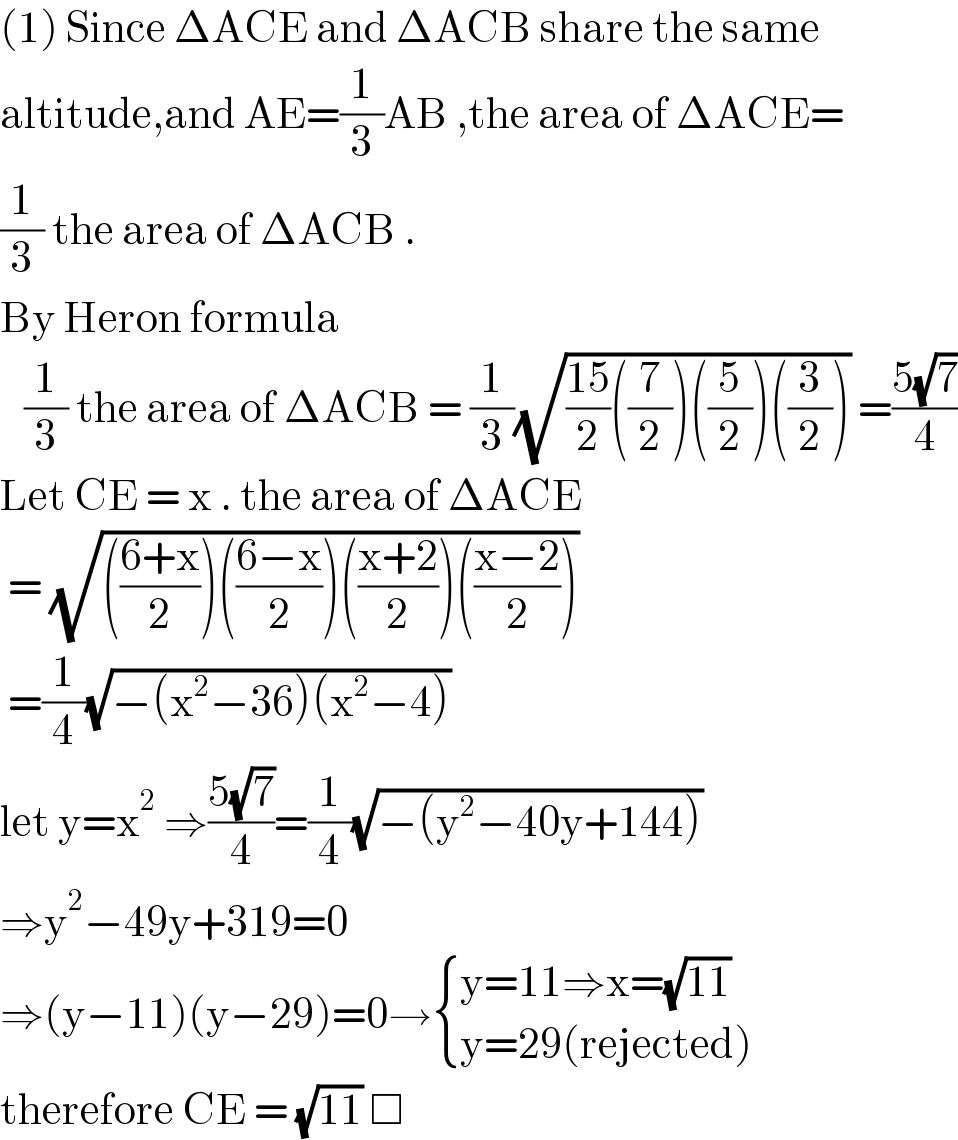Question Number 143003 by bramlexs22 last updated on 08/Jun/21

Answered by EDWIN88 last updated on 08/Jun/21

$$\left(\mathrm{1}\right)\:\mathrm{Since}\:\Delta\mathrm{ACE}\:\mathrm{and}\:\Delta\mathrm{ACB}\:\mathrm{share}\:\mathrm{the}\:\mathrm{same} \\ $$$$\mathrm{altitude},\mathrm{and}\:\mathrm{AE}=\frac{\mathrm{1}}{\mathrm{3}}\mathrm{AB}\:,\mathrm{the}\:\mathrm{area}\:\mathrm{of}\:\Delta\mathrm{ACE}= \\ $$$$\frac{\mathrm{1}}{\mathrm{3}}\:\mathrm{the}\:\mathrm{area}\:\mathrm{of}\:\Delta\mathrm{ACB}\:.\: \\ $$$$\mathrm{By}\:\mathrm{Heron}\:\mathrm{formula}\: \\ $$$$\:\:\:\frac{\mathrm{1}}{\mathrm{3}}\:\mathrm{the}\:\mathrm{area}\:\mathrm{of}\:\Delta\mathrm{ACB}\:=\:\frac{\mathrm{1}}{\mathrm{3}}\sqrt{\frac{\mathrm{15}}{\mathrm{2}}\left(\frac{\mathrm{7}}{\mathrm{2}}\right)\left(\frac{\mathrm{5}}{\mathrm{2}}\right)\left(\frac{\mathrm{3}}{\mathrm{2}}\right)}\:=\frac{\mathrm{5}\sqrt{\mathrm{7}}}{\mathrm{4}} \\ $$$$\mathrm{Let}\:\mathrm{CE}\:=\:\mathrm{x}\:.\:\mathrm{the}\:\mathrm{area}\:\mathrm{of}\:\Delta\mathrm{ACE}\: \\ $$$$\:=\:\sqrt{\left(\frac{\mathrm{6}+\mathrm{x}}{\mathrm{2}}\right)\left(\frac{\mathrm{6}−\mathrm{x}}{\mathrm{2}}\right)\left(\frac{\mathrm{x}+\mathrm{2}}{\mathrm{2}}\right)\left(\frac{\mathrm{x}−\mathrm{2}}{\mathrm{2}}\right)} \\ $$$$\:=\frac{\mathrm{1}}{\mathrm{4}}\sqrt{−\left(\mathrm{x}^{\mathrm{2}} −\mathrm{36}\right)\left(\mathrm{x}^{\mathrm{2}} −\mathrm{4}\right)} \\ $$$$\mathrm{let}\:\mathrm{y}=\mathrm{x}^{\mathrm{2}} \:\Rightarrow\frac{\mathrm{5}\sqrt{\mathrm{7}}}{\mathrm{4}}=\frac{\mathrm{1}}{\mathrm{4}}\sqrt{−\left(\mathrm{y}^{\mathrm{2}} −\mathrm{40y}+\mathrm{144}\right)} \\ $$$$\Rightarrow\mathrm{y}^{\mathrm{2}} −\mathrm{49y}+\mathrm{319}=\mathrm{0} \\ $$$$\Rightarrow\left(\mathrm{y}−\mathrm{11}\right)\left(\mathrm{y}−\mathrm{29}\right)=\mathrm{0}\rightarrow\begin{cases}{\mathrm{y}=\mathrm{11}\Rightarrow\mathrm{x}=\sqrt{\mathrm{11}}}\\{\mathrm{y}=\mathrm{29}\left(\mathrm{rejected}\right)}\end{cases} \\ $$$$\mathrm{therefore}\:\mathrm{CE}\:=\:\sqrt{\mathrm{11}}\:\Box \\ $$
Commented by EDWIN88 last updated on 08/Jun/21
![the other way (1) by applying Stewart′s theorem to ΔABC ⇒(AC)^2 (EB)+(CB)^2 (AE)=AB [ (CE)^2 +(AE)(EB)] ⇒4^2 .4+5^2 .2 = 6[ (CE)^2 +2.4 ] ⇒114 = 6(CE)^2 +48 ⇒CE =(√((114−48)/6)) = (√((66)/6)) = (√(11)) □](https://www.tinkutara.com/question/Q143005.png)
$$\mathrm{the}\:\mathrm{other}\:\mathrm{way} \\ $$$$\left(\mathrm{1}\right)\:\mathrm{by}\:\mathrm{applying}\:\mathrm{Stewart}'\mathrm{s}\:\mathrm{theorem}\:\mathrm{to}\:\Delta\mathrm{ABC} \\ $$$$\Rightarrow\left(\mathrm{AC}\right)^{\mathrm{2}} \left(\mathrm{EB}\right)+\left(\mathrm{CB}\right)^{\mathrm{2}} \left(\mathrm{AE}\right)=\mathrm{AB}\:\left[\:\left(\mathrm{CE}\right)^{\mathrm{2}} +\left(\mathrm{AE}\right)\left(\mathrm{EB}\right)\right] \\ $$$$\Rightarrow\mathrm{4}^{\mathrm{2}} .\mathrm{4}+\mathrm{5}^{\mathrm{2}} .\mathrm{2}\:=\:\mathrm{6}\left[\:\left(\mathrm{CE}\right)^{\mathrm{2}} +\mathrm{2}.\mathrm{4}\:\right] \\ $$$$\Rightarrow\mathrm{114}\:=\:\mathrm{6}\left(\mathrm{CE}\right)^{\mathrm{2}} +\mathrm{48} \\ $$$$\Rightarrow\mathrm{CE}\:=\sqrt{\frac{\mathrm{114}−\mathrm{48}}{\mathrm{6}}}\:=\:\sqrt{\frac{\mathrm{66}}{\mathrm{6}}}\:=\:\sqrt{\mathrm{11}}\:\Box \\ $$
Commented by bramlexs22 last updated on 09/Jun/21

$${nice} \\ $$
